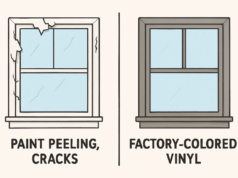Spend Before You Sell Your Home: Yes? No? Maybe?
Selling your house to move closer to a new job or for retirement is a sure-fire way to increase your anxiety over your furnishings and the overall state of the nest you called home for all those years.
Should you paint? Should you just clean up? Should you buy new furniture to make your home look snazzy for a prospective buyer? Will any of this increase your sales price?
Let’s start with the basic fact of selling a home. Generally, unless it is specified in writing somewhere, what is nailed down, screwed into place or bolted to the house is considered a home furnishing and those items – wall sconces, baths, toilets, sinks, outlet covers, doorknobs, etc. – stay with the house when it is sold. Furniture, on the other hand – beds, dressers, chairs, tables and bookshelves – go with the owner. Large appliances are also part of the home, unless otherwise noted. Countertop appliances, however, are not considered part of the house.
This puts an important twist on the notion of buying new stuff to increase your sales price. Investing in new wall sconces or a new kitchen sink might be just the touches your home needs, but you are not likely to take those types of items with you once the house is sold.
An exception might be an expensive wall sconce that you do plan to keep. Let buyers know on their first tour that that is not going to be part of the sale.
Your first step, regardless, should be to inspect your property thoroughly. You can stop at professional inspections of water or septic systems, unless you are clearly suspicious there might be a problem revealed when these mandatory inspections are done at the time of sale. (When you finally have a home buyer lined up, it is not a great time for unpleasant surprises.)
Make a long, detailed check list. Is the paint peeling or just drab? Are there holes in the walls, the floor or the ceiling? Are the window sills dirty, drafty or both? Will your current set of furniture have a negative affect on the prices of the home or a positive one? Are there obvious odors – dogs, cats, mildew – that need to be addressed?
Many experts advise home sellers to seek consultation through an interior decorator or through an online resource like Boyles Furniture. Here you can start with two basic questions: Does your current furniture have any resale value? And what is the price range for options when buying a new set for your soon-to-be-sold home?
But here is the simple trick I learned in business school. When you buy new furniture to perk up the place, err on the conservative side. Aim for colors that are neutral, such as beige, off-white, tan or light shades of blue, green or red.
The reason is the often-told adage: There is no accounting for taste.
In other words, for many buyers, if you go with a snazzy red tint to your wall paint (for example), they will shrug and say, “Not my taste.” If you put up new rose-patterned drapes, some will like them, others will hate them. Only a few will love them, because it is not precisely what they would have chosen for themselves.
As such, the more exotic you go, the more you have a chance of alienating some buyers. It’s just a fact of life. You spend a fortune on what you think is the perfect color for your kitchen tiling and the first potential buyer walks in an says, “I would have gone with something else.” In any of these taste-oriented decisions, it’s impossible to please everybody.
On the other hand, there are certainly items that you can count on to bring a negative reaction. That would be: dirt, holes in the wall, leaking roofs, paint that is obviously peeling and necessities – like electricity, plumbing, doors – that need repairs.
So, one rule of thumb might be this: When you spend on new stuff, you should do it with yourself in mind, not the next buyer, unless its something that will clearly be a drag on your selling price. If that is the case, aim for something modest or conservative that will find approval among the greatest number of people.
Eventually, the point is to just sell the house, not to fix everything in sight. One check list I read suggested wisely not to add a new room just to increase the size of the home before you sell. If the home is small, you might have to wait for the right buyer to come along, but you should spend your money on your next home, not gamble your money on issues of taste on the one you are trying to sell.














